Keywords
|
| Data stream, Data stream Clustering, Outlier detection, CURE, K-Means, CLARANS |
INTRODUCTION
|
| Data mining is broadly studied field of research area, where most of the work is highlighted over knowledge discovery, in that data stream is one of the research areas in data mining because data stream data are massive, fastchanging, unlimited, continuous flow and infinite. Applications of data streams can vary from scientific and astronomical applications to important business and financial ones therefore, real-time analysis and mining of data streams have attracted substantial amount of researches. Data stream clustering is a sub-area of mining data streams, since the clustering algorithms arrange a dataset into several disjoint groups, such that points in the same group are related to each other and are unrelated to other groups, according to some similarity metrics. In order to use clustering in data streams, the requirements are [14] to be generated for overall high-quality clusters without seeing the old data, high quality, efficient incremental clustering algorithms and analysis in multi-dimensional space. There are several types of clustering techniques are useful for outlier detection. The hierarchical algorithms create a hierarchical decomposition of the objects and they are either agglomerative bottom-up or divisive top-down. Agglomerative algorithms start with each object, and successively merge groups according to a distance measure, where as the clustering may stop when all objects are in a single group or at any other point the user wants and these methods called as greedy bottom-up merging. Divisive algorithms [6] follow the reverse approach, it starts with single group of all objects and successively split groups into smaller ones, until all object falls into single cluster, are to be preferred. Partitioning algorithm constructs various partitions for the data elements and then evaluates them by some criteria. |
| Density based algorithms (DBSCAN) has been designed for the clustering of large noisy datasets on spatial data. DBSCAN introduced the concept of neighborhoods as a region of given radius in a sphere and including a minimum number of data points. Connected neighborhoods form clusters, thus leaving from the notion of spherical cluster. It produces clusters according to a density-based connectivity analysis. In order to perform clustering in data streams, we cannot save all the incoming data objects due to limited memory. The transactional clustering algorithm CLU-TRANS has been mainly used for two components they are online and offline transactions based on sliding window, in each sliding window had been assigned to the equal minimum clustering granularity to ensure that clustering time for the minimum granularity. Data stream clustering methodologies are highly helpful to detect outliers and outlier detection is one of the data mining tasks and it is otherwise called as outlier mining. Outlier detection over streaming data is active research area from data mining that aims to detect object which have different behavior, exceptional than normal object. An outlier is an object [8] that is significantly dissimilar or inconsistent to other data object whereas telecommunication, fraud detection, web logs, click stream and web document are the application areas of outlier detection in data streams. There are many algorithms for outlier detection in static and stored data sets which are based on a variety of approaches like distance based outlier detection, density based outlier detection, nearest neighbor based outlier detection and clustering based outlier detection so on. The rest of this paper is followed as Section 2 illustrates the review of literature. Section 3 explains about the Cure with K-Means and CURE with CLARANS clustering algorithms used to detect outliers in data streams. Experimental results are discussed in Section 4 and Conclusions are given in Section 5. |
LITERATURE REVIEW
|
| Sudipto Guha, et.al [12] proposed a clustering algorithm called CURE and it is used for detecting outliers. CURE achieves by representing point per cluster its allow CURE to adjust well to the geometry of non-spherical shapes and the reduction helps to reduce the effects of outliers. The combination of random sampling and partitioning and the experimental results confirm that the quality of clusters produced by CURE is much better than those found by existing algorithms. Moreover, the authors expressed the partitioning and random sampling enable CURE to not only outperform existing algorithms but also to scale well for large databases without sacrificing the quality of cluster. |
| Elahi, M. Kun Li, et.al [7] discussed about a clustering based approach, it divide the stream into chunks and for cluster each chunk using k-mean in fixed number of cluster. In this research the author took the candidate outliers and mean value of every cluster for the next fixed number of data streaming chunks, to make sure that the detected candidate outliers are the real outliers. The mean value are used in the clusters of previous streaming chunk and the current chunk of mean values are taken to be the consideration, which is used to choose better outlierness for data stream objects. Quite a few experiments for different types of dataset confirm that the technique can find better outliers with low computational cost than the other existing distance based approaches of outlier detection in data stream. |
| Carlos Ordonez, et.al [5] talked about three variants of the K-means algorithm to cluster binary data streams. Variants are On-line K-means, Scalable Means, On-line K-means and Incremental K-means proposed a variant introduced that finds higher quality solution in less time. All variants were compared with real and synthetic data sets. The proposed Incremental K Means variant is faster than the already quite fast Scalable K-means and finds solution of comparable quality. The K-means variants are compared with respect to quality of speed and results. The proposed algorithms can be used to check the transactions. Further in this research the author discussed about the acceleration of Incremental Kmeans algorithm is not possible unless approximation, randomization or samplings are used. |
| Sharma.M, et.al [11] has conversed about the algorithm of k means for clustering of data streams and detection of outliers. The technique which has been used for outlier detection is based on distance as well as on time, on which they arrive in the cluster. The author takes into account the selection of k centers and variable size of buckets with the help of which space can be effectively utilized during clustering. Most traditional algorithms makes very difficult problem in clustering by reducing their quality for a better efficiency. In this research the author indicates a small increase of time, due to this cause the cluster can efficiently cluster the data without much loss of quality of data. |
| Thankran.Y, et.al [13] put forwarded an unsupervised outlier detection method for streaming data. This method is based on clustering as clustering is an unsupervised data mining task and it does not require labeled data. In this proposed method both density based and partitioning clustering method are combined to take advantage of both density and distance based outlier detection. It assigns weights to attributes depending upon their respective relevance in mining task and weights are adaptive in nature. Weighted attributes are helpful to decrease the effect of noisy attributes. The proposed method is incremental and adaptive to concept evolution. |
METHODOLOGY
|
| Clustering and Outlier detection is one of the important tasks in data streams. Outlier detection is based on clustering approach and it provides new positive results. The main objective of this research work is to perform the clustering process in data streams and detecting the outliers in data streams. In this research work, two clustering algorithms namely CURE with K-Means and CURE with CLARANS are used for clustering the data items and finding the outliers in data streams. The system architecture of the research work is as follows: |
| A. DATASET |
| In order to compare the data stream clustering for detecting outliers, data sets were taken from UCI machine learning repository. Datasets namely Breast Cancer Wisconsin Dataset with 699 instances, 10 attributes and Pima Indian data set contain 768 instances and 8 attributes. These two biological data sets have numeric attributes which have been used in this research work. Data stream is an unbounded sequence of data as it is not possible to store complete data stream, for this purpose we divide the data into chunks of same size and each chunk size is specified by the user which depends upon the nature of data and finally we divided the data into chunks of same size in different windows. |
| B. CLUSTERING |
| The clustering algorithm is used to group objects into significant subclasses and the clustering data streams are a sub area of mining data streams. The clustering algorithms for data streams should be adaptive in the sense that up to date clusters are obtainable at any time, taking new data items into account as soon as they arrive. There are different types of clustering algorithms are fitting for different types of applications they are chased by Hierarchical clustering algorithm, Partition clustering algorithm, Density based clustering algorithm and Grid based clustering algorithm. Clustering is defined as an unsupervised problem. There are no predefined class label exists for the data points. Cluster analysis is used in a number of applications such as data analysis, image processing, Stock market analysis etc. |
| C. OUTLIER DETECTION |
| Outlier detection has a wide range of applications such as insurance, fraud detection, intrusion detection, credit card and so on. It is further complicated by the fact that in many cases outliers have to be detected from a large volume of data growing at an unlimited rate [8].Traditional outlier detection algorithms cannot be applied to data stream efficiently since data stream is potentially infinite and evolving continuously. It has to be processed within a strict time constraint and limited space, thus outlier detection in data stream inflicts great challenges are followed as single scan. [9]. Outlier detection in data stream should be done very fast, preferably in single-scan and it is more complicated in data stream because it is difficult to build different data distribution basis in developing. Existing algorithms regard the model learned has the only distribution for detecting outliers and it also satisfy the evolving characteristics of data stream and may be too conservative to detect important outliers. So for that clustering based outlier detection is a best technique to manage this problem. For our research we have used cluster based outlier detection as CURE with Kmeans and CURE with CLARANS. |
| D. CURE CLUSTERING |
| CURE (Clustering Using Representatives) is an efficient data clustering algorithm for data streams that is more robust to outliers and identifies clusters having non-spherical shapes and wide variances in size. Cure is one of the hierarchical methods decompose a dataset into a tree-like structure. To avoid the problems with non-uniform sized or shaped clusters, it employs a hierarchical clustering algorithm that adopts a middle ground between the centroid based and all point extremes. In each iteration, it has a constant number c of well scattered points of a cluster are chosen and they are shrunk towards the centroid of the cluster by a fraction α. The scattered points after shrinking are used as representatives of the cluster. The clusters with the closest pair of representatives are the clusters that are merged at each step of CURE's hierarchical clustering algorithm. This allows CURE to correctly identify the clusters and makes it less sensitive to outliers [15]. CURE algorithm followed as |
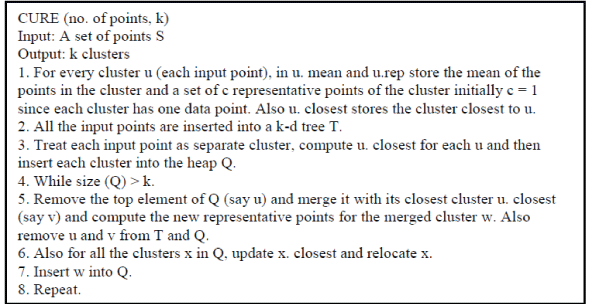 |
| The running time of the algorithm is O (n2 log n) and space complexity is O (n). The algorithm cannot be straightly applied to large databases. So for this reason the random samplings are used to handle data sets and generally the random sample fits in main memory due to the random sampling there is a tradeoff between accuracy and competence. The basic idea is to partition the sample space into p partitions. In first pass the cluster are to be partition until the final number of clusters reduces to np /q for a few constant q ≥ 1. Run a second clustering pass on n/q partial clusters for all the partitions. For the second pass store the representative points for the merge. Merge requires the representative points of previous clusters before computing the new representative points for the merged cluster. Advantage of partitioning the input is used to reduce the execution times. The points for k clusters, the outstanding data points should be assigned to the clusters. Representative points for each of the k clusters are to be selected for fraction in order to choose the data point is assigned to the cluster containing the representative point closest to it. |
| E. K-MEANS CLUSTERING |
| K-Means clustering is a backbone method for detecting outliers. K-Means clustering requires iterative optimization of clustering centroids to gradually achieve better clustering results. This optimization process involves multiple data scans, which is infeasible in the context of data streams. K-mean describes that given dataset of n object divide into k cluster where k is desired number of cluster. A centroid is defined for each cluster in k-mean all data object are placed in cluster having centroid nearest to all data object. After processing all data object then k-mean centroid is calculated again and again. For each centroid it changes their location and its need to specify k number of cluster in advance. This process continues step by step until no centroid move. K-Means algorithm follows as |
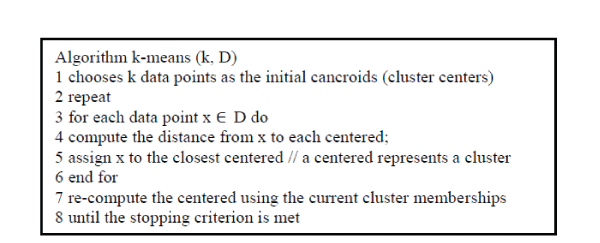 |
| F. CLARANS CLUSTERING |
| CLARANS [15] clustering algorithm is nothing but it is used for randomized search and CLARANS is abbreviated as Clustering Large Application Based upon Randomized Search. Ng and Han proposed a new algorithm in 1994 called CLARANS. It uses random search to generate neighbours by starting with arbitrary node and randomly check maxneighbours, where ever if the neighbor represent better partition the process continue with new node otherwise local minimum is found and algorithm restart until num local minima is found (value of num local is=2 recommended)the best node return resulting partition. CLARANS take a random dynamic selection of data at each step of process. Thus the same sample set is not used throughout in the clustering process. As a result better randomization source is achieved. CLARANS is accurately detecting outlier than CLARA and it is much less affected by increasing dimensionally and draw the sample of neighbours in each step of search this is benefit of confining the search localize area. CLARANS algorithm followed as |
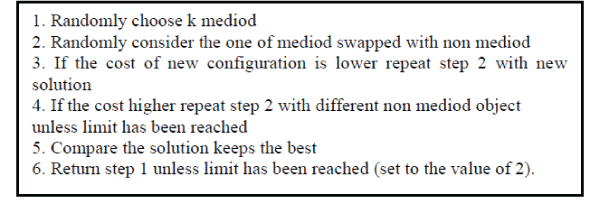 |
EXPERIMENTAL RESULTS
|
| A. CLUSTERING ACCURACY |
| Clustering accuracy is calculated, by using two measures precision and recall. The clustering algorithms CURE with K-MEANS and CURE with CLARANS for Pima Indian diabetes and Wiscosin-breast cancer data set. Table I & Table II show the clustering accuracy, precision and recall in three windows and five windows. |
| From the above graph, it is observed that CURE with CLARANS clustering algorithm performs better than CURE with K-Means clustering algorithms in Pima Indian Diabetes dataset and Breast cancer Wiscosin for both window size as five and three. Therefore the CURE with CLARANS clustering algorithm performs well because it contains high clustering accuracy when compared to CURE with K-Means. |
| B. OUTLIER ACCURACY |
| A. DETECTION RATE AND FALSE ALARM RATE FOR PIMA INDIAN DIABETES |
| Outlier detection accuracy is calculated, in order to find out number of outliers detected by the clustering algorithms CURE with K-MEANS and CURE with CLARANS for Pima Indian diabetes data set. Table III & Table IV shows the number of outlier detection rate and false alarm rate in three windows and five windows. |
| From the above graph, it is observed that CURE with CLARANS clustering algorithm performs better than CURE with K-Means algorithms for detecting outliers in Pima Indian Diabetes dataset for both window size as five and three. Therefore the CURE with CLARANS clustering algorithm performs well because it contains high outlier detection accuracy when compared to CURE with K-Means. |
| B. DETECTION RATE AND FALSE ALARM RATE FOR BREAST CANCER (WISCOSIN) |
| Outlier detection accuracy is calculated, in order to find out number of outliers detected by the clustering algorithms CURE with K-Means and CURE with CLARANS for Breast cancer –Wiscosin data set. Table V & Table VI shows the number of outlier detection rate and false alarm rate in three windows and five windows. |
| From the above graph, it is observed that CURE with CLARANS clustering algorithm performs better than CURE with k-means algorithms for detecting outliers in both biological data set as Pima Indian diabetes and Breast Cancer (Wiscosin) in three windows as well as in five windows. Therefore the CURE with CLARANS clustering algorithm performs well because it contains high outlier detection accuracy when compared to birch with k-means. |
CONCLUSION
|
| Data streams are dynamic ordered, fast changing, massive, limitless and infinite sequence of data objects. Data streams clustering technique are highly helpful to handle those data and outlier detection is one of the challenging areas in data stream. By using data stream hierarchical clustering and partition clustering are helpful to detect the outliers efficiently. In this paper we have analyzed the performance of CURE with K-Means and CURE with CLARANS clustering algorithm for detecting the outliers. In order to find the best clustering algorithm for outlier detection several performance measures are used. From the experimental results it is observed that the outlier detection accuracy is more efficient in CURE with CLARANS clustering while compare to CURE with K-Means with clustering. |
Tables at a glance
|
|
|
|
|
| |
Figures at a glance
|
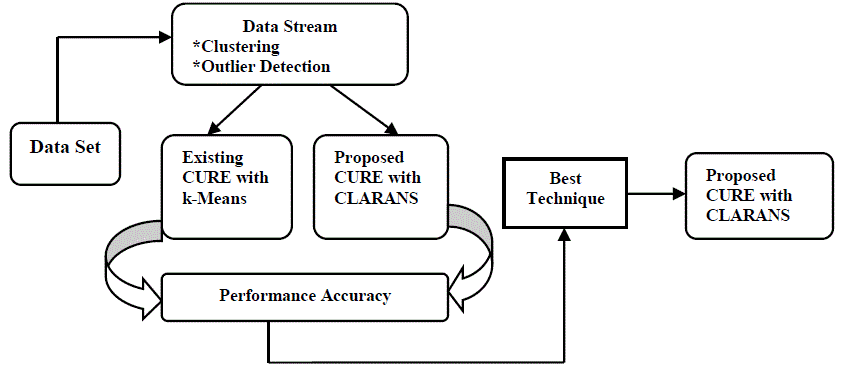 |
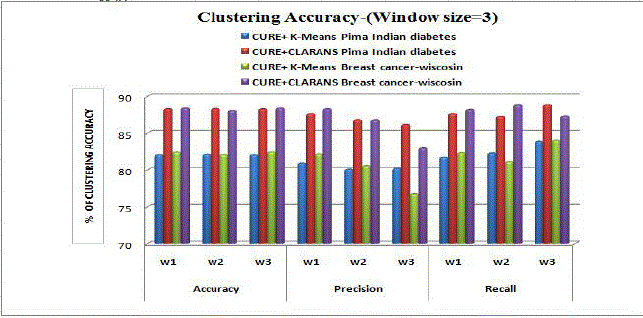 |
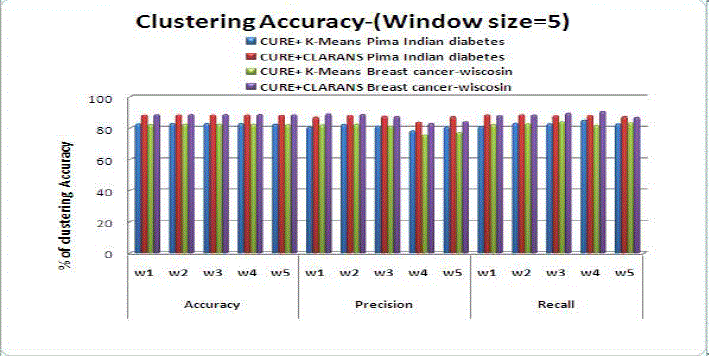 |
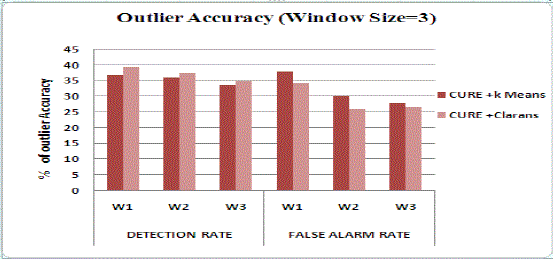 |
| Figure 1 |
Figure 2 |
Figure 3 |
Figure 4 |
|
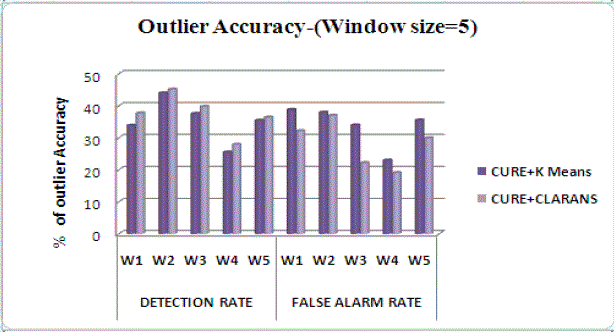 |
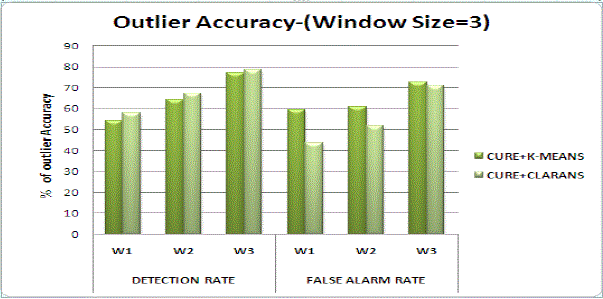 |
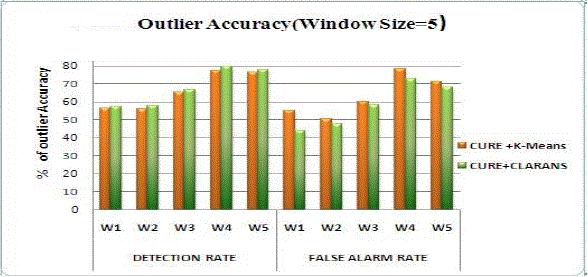 |
| Figure 5 |
Figure 6 |
Figure 7 |
|
References
|
- C. Aggarwal, Ed, “Data Streams – Models and Algorithms”, Springer, 2007.
- C. Aggarwal, J. Han, J. Wang, P.S. Yu, “A framework for projected clustering of high dimensional data streams”, in Proceedings of the 30thVLDB Conference, Toronto, Canada, pp. 852-863, 2004.
- Bakar. Z, A. Mohemad, R .Ahmad, A. &Deris, M. M, “A comparative study for outlier detection techniques in data mining”, IEEE Conf.Cybernetics and Intelligent Systems, Bangkok, Thailand, pp. 1–6,2006.
- D.Barbara, “Requirements for clustering data streams”, ACM SIGKDD, Volume3 Issue 2, Pages 23-27 , January 2002.
- Carlos Ordonez, “Clustering Binary Data Streams with K-means”, proceedings of ACM international conference on management of data, sigmod1998.
- Chandrika.J, Dr. K.R. Ananda Kumar, “Dynamic Clustering Of High Speed Data Streams”, IJCSI International Journal of Computer ScienceIssues, Vol. 9, Issue 2, No 1, March 2012.
- Elahi, M. KunLi, Nisar, W. XinjieLv, HonganWang, “Fuzzy Systems and Knowledge Discovery”, Fifth International Conference on Vol.5, andVol .3, pp. 23-27, 2002.
- D. Hawkins, “Identification of outliers-Monographs on statistics and applied probability”, First edition, pages-188, Springer published in 1980.
- Irad Ben-Gal, “Outlier Detection”, Data Mining and Knowledge Discovery Handbook: A Complete Guide for Practitioners and Researchers,Kluwer , Academic Publishers, 2005.
- L. O’ Callaghan , “ Clustering data streams theory and practice”, IEEE transactions on knowledge and data engineering, Vol. 15, NO. 3,2003.
- MadjidKhalilian, Norwati Mustapha , “Data Stream clustering-Challenges and issues”, Proceedings of the International Multi Conference ofEngineers and Computer Scientists , Hong Kong ,Vol I,pp.17 - 19,March 2010.
- Sharma, M. Toshniwal, D, “ Pre-clustering algorithm for anomaly detection and clustering that uses variable size buckets”, Published in RecentAdvances in Information Technology (RAIT), 1st International Conference on 15-17 March 2012.
- SudiptoGuha, Rajeev Rastogi, Kyuseok Shim, “CURE: an efficient clustering algorithm for large databases”, ACM LIBRARY, 1999.
- Thakran. Y, Toshniwal .D, “ Unsupervised outlier detection in streaming data using weighted clustering”, Intelligent Systems Design andApplications (ISDA), 2012.
- T. SoniMadhulatha, “overview of streaming-data algorithms”, Advanced Computing: An International Journal (ACIJ), Vol.2, No.6, November2011.
- Yi-honglu, Yan huang, “Mining DataStreams Using Clustering”, Proceedings of the Fourth International Conference on Machine Learning andCybernetics,vol.4, pp. 18-21,2005.
|